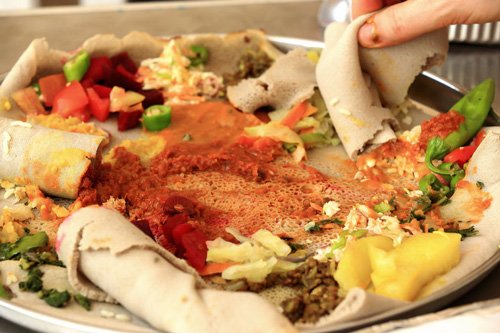Reading Comprehension Text and Exercises
Interesting Dining Manners in Different Cultures
Around the world, people gather to eat lunch or dinner. Every culture has developed this social ritual in different ways, so today there are certain rules that need to be respected while eating – for example, how to use utensils (knife, fork, spoon) correctly or when to ask to be served. We call them dining or table manners.
These rules differ from one culture to another, so what is considered to be polite in one society can be seen as very rude somewhere else!
Click Here for Step-by-Step Rules, Stories and Exercises to Practice All English Tenses
A Brief History of Table Manners in Europe
- Most table manners that Europeans and North Americans practice today originate from the Age of Exploration in the 1500s. It is believed that dinners became more refined when Catherine de' Medici, who was the Pope's niece, married the future King of France Henry II. She was appalled by the fact that French people did not use forks, and had greasy hands from cutting the meat.
- Around that time, a few more educated people, like Erasmus of Rotterdam (a Dutch scholar), had already written about the use of utensils and restraining oneself from eating quickly. At that time, knives, spoons and cups were shared among all those sitting at the table, and soups were drunk directly from the bowl.
- Soon after, individual cutlery was introduced, and napkins were adopted to protect the diners' clothes. Even today, it is a good table manner to put the napkin on the lap.
Hands Up, France
When in France, you might be advised to always rest your wrists or forearms (but not elbows) on the table while you are not using utensils to eat. Keeping your hands under the table where nobody can see them is considered a bad dining manner.
In many other countries in Europe and North America, "hands on the table" is one of the basic dining rules, particularly reiterated to children. Why is that? Some people suggest this tradition started because people were afraid of what other people might be doing under the table, like holding a weapon.

Siesta, Spain
If you find yourself in Spain during the summer, you will notice that many shops are closed in the early afternoon, even on a regular work day. The reason they are closed is siesta, a short nap people take after lunch.
The word siesta, meaning "nap" in Spanish, derives from the Latin word sexta, meaning the sixth hour (counting from the dawn), which explains why siesta is usually taken around noon.
This particular dining ritual can be explained by the very high temperatures during the summer, and the great amount of food a typical midday meal in Spain includes. These two together make people very sleepy, so they made it a nation-wide acceptable habit to take a break from work in the middle of the day and get some rest.

Slurping, East and South Asia
While in most European cultures making any noise while drinking or chewing is considered to be very rude, in places like Japan and China those who slurp their soups have good dining manners.
In other words, slurping your soup or noodles very loudly sends a message to the chef or the host that the food is delicious. The more loudly you slurp it, the more appreciation for the meal you show. If by any chance you forget to do it, the cook could be very offended or hurt thinking that you did not enjoy their meal!

Eating With Hands, Ethiopia
Traditionally, Ethiopian food is eaten with hands, usually from a large communal plate. Several delicious meals are put together in a plate with some injera, a flat Ethiopian bread, and the guests sit around it.
The proper way to eat Ethiopian food is to tear off a piece of the bread, grab some food that is close to you with it, and put it in your mouth. Because you are touching the food with your hands, make sure that you always wash them before and after the meal. The left hand is considered unclean, so it is advisable and polite to only use your right hand to eat.

No Extra Cheese, Italy
Italian cuisine is known for using a great variety of cheese in large quantities. Italian pizzas and pastas are particularly rich in cheese. In an Italian restaurant anywhere in the world, the parmesan cheese might even be freshly grated in front of you on your plate.
However, unless cheese is offered to you, you should not ask for extra cheese for a dish like pizza which already has a lot of cheese. Such an act is considered to be an insult to the cook, so most waiters will simply refuse to bring more cheese.
Another cheese-related rule in Italy applies to seafood – adding cheese to a seafood pasta is unimaginable according to traditional dining manners, so it is best you avoid it.

Comprehension Exercises
Vocabulary Questions
- What does "reiterate" mean?
- demand
- repeat
- forgive
- What does "appalled" mean?
- feeling shocked or disgusted
- being concerned
- liking something very much
- What does "refined" mean?
- improved, elegant
- rejected, disliked
- done again
- What does "cutlery" mean?
- the act of cutting bread
- decrease one's debt
- cutting utensils
- What does "exploration" mean?
- hiding something from someone
- searching and finding out about something
- changing the rules
Collocation Questions
- Many shops in Spain are closed in the __________ afternoon.
- primary
- early
- first part of the
- Italians eat cheese in large __________.
- quantities
- sums
- volumes
- You should always __________ your wrists on the table.
- lay
- relax
- rest
- Ethiopian food is usually served in a large __________ plate.
- communal
- mass
- joint
- Asking for more cheese is an insulting __________.
- gesture
- act
- move
- Start eating by tearing __________ a piece of bread.
- up
- away
- off
- In many cultures, the left hand is considered __________.
- impure
- unclean
- stained
- Catherine de' Medici was appalled __________ the behavior of the French.
- about
- of
- by
- Taking a siesta is __________ habit all over Spain.
- an acceptable
- a justifiable
- a bearable
- Erasmus thought people should __________ themselves from eating quickly.
- repress
- restrain
- limit
Wh Questions
- Why do people take siestas?
- because the weather is hot
- because the law requires it
- because cooking takes a long time
- Where should you put your napkin during dinner?
- around your neck
- on the table
- on the lap
- What should you never add to seafood in Italy?
- pasta
- cheese
- olive oil
- How does slurping compliment the cook in Japan?
- it means they will get a tip
- it means the food is delicious
- it means they are good-looking
- When did Europeans adopt forks and spoons?
- from the 16th century onwards
- 2,000 years ago
- in the 20th century
Evaluating Statements
- Based on the information in this lesson, which statement is true?
- Siestas always last from 3pm to 5pm.
- Siestas are usually taken around midday.
- Based on the information in this lesson, which statement is false?
- When in France, the best advice is to rest your elbows on the table.
- When in France, the best advice is to rest your wrists on the table.
True or False?
- Based on the information in this lesson, is the following statement true or false?
"During a meal in Ethiopia, always reach across the table to get food." - True
- False
- Based on the information in this lesson, is the following statement true or false?
"In Italy, if the waiter offers you cheese, it is okay to take it." - True
- False
Answer Key
1. B | 2. A | 3. A | 4. C | 5. B | 6. B | 7. A | 8. C | 9. A | 10. B | 11. C | 12. B | 13. C | 14. A | 15. B | 16. A | 17. C | 18. B | 19. B | 20. A |21. B | 22. A | 23. B | 24. A
Get Updates, Special Offers, and English Resources
Download your FREE GIFT (the first two chapters of
English Short Stories Book and Workbook)
as soon as you join!

By submitting your email, you consent to receiving updates and newsletters from us and to the sharing of your personal data with third parties for the purposes of sending you communications. We will not spam you. You can unsubscribe at any time. For more information, please see our privacy policy.





